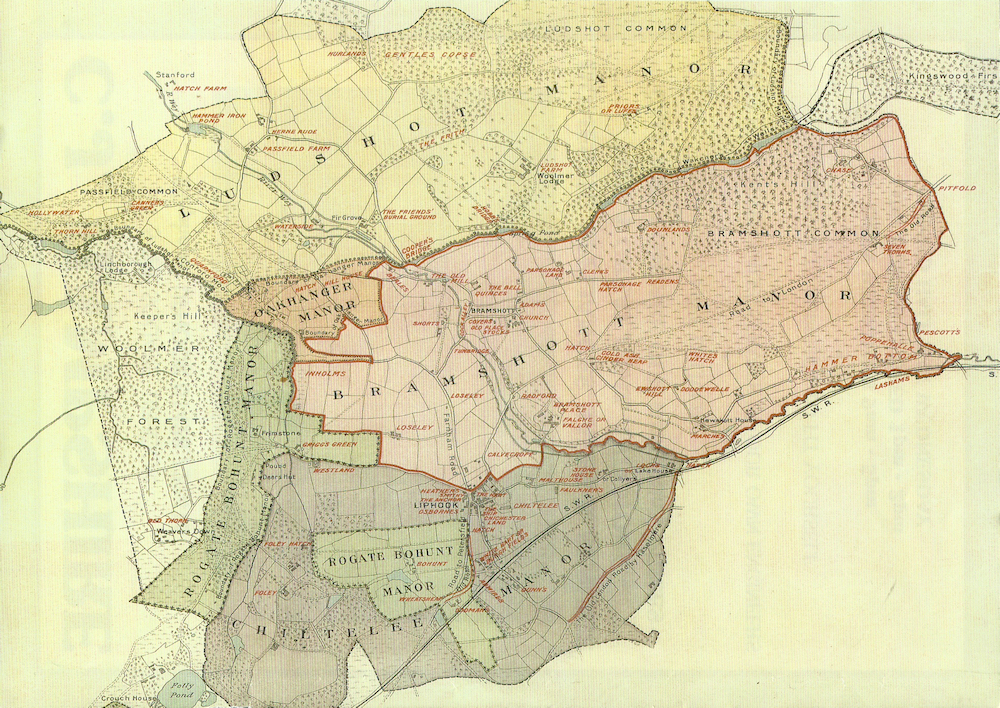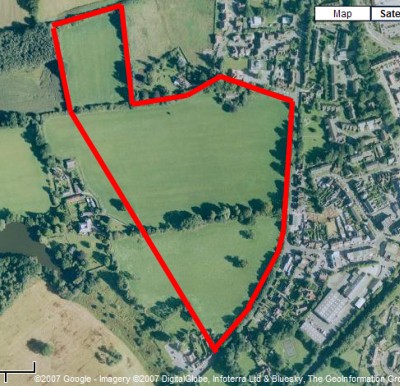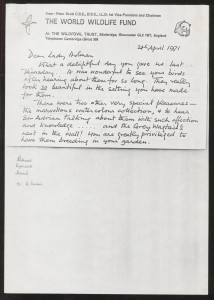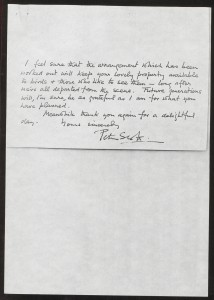Middle Ages to the 21st Century
Bohunt Manor in Liphook was originally a part of Sussex, called the Manor of Rogate-Bohunt. As can be seen in this map the present parish of Bramshott & Liphook had three ancient manors—Bramshott, Chiltlee and Ludshott in their entirety. Interspersed amongst these three manors are outlying parts of Rogate-Bohunt Manor, an offspring of Harting Manor.
In the Mediaeval Period in England a manor was defined as the district over which a lord had domain and could exercise certain rights and privileges. Manors were mainly used for agriculture, but might also have woods, orchards, gardens, and lakes or ponds where fish could be found. On the manor lands, usually near the village, one could often find a mill, bakery, and blacksmith. Manors were largely self-sufficient. The woods of Rogate-Bohunt Manor, adjacent to the Royal Wulmer (Woolmer) Forest, would have been of great value for hunting and lumber, used for the building of ships and homes and to stoke the fires of the local iron furnaces that produced armaments.
Feudalism was based on the exchange of land, called a fief, for military service. It seems probable that Rogate was originally part of the Manor of Hertinges (Harting), and that it was given by William, Earl of Arundel to Savaric son of Cane, an ancestor of the Bohuns of Midhurst, or to Ralph son of Savaric, his son. Ralph’s lands were divided after his death, in 1158, between his brothers Geldwin and Savaric. In the early 1200s the land came into the ownership of the de Chesney family.
It belonged consequently to John, Lord Lumley (1583), Sir Thomas Bettesworth of Trotton (1594), Sir Peter Bettesworth of Miland (1635), Humphrey Stewart (1638), John Stewart (1662), Thomas Stewart (1701), John Reeves (1719), Thomas Ridge of Portsmouth (1723), Humphrey Ridge (1729), Sir Thomas Ridge (1732), William Richardson (1770), John Utterson (1781), Sir Charles Taylor (1804), Sir John Hawkshaw (1866) and Oliver Hawkshaw (1891-1923).
Although the area was known as the Manor of Rogate-Bohunt since 1158, the first recorded mention was in 1565, in reference to a farm building. Around 1770 William Richardson rebuilt the old house, retaining an extensive walled garden. In 1923 the house was put up for sale as part of the Foley Estate and in 1927 a new house designed by Unsworth was built on the site of the 18th century house.
In 1954 the estate was bought by the British Diplomat Sir Adrian and Lady “Betty” Holman, after returning to England from a life in diplomatic service. They rejuvenated the garden and dredged the lake, receiving advice on landscaping and planting from George Brown, Assistant Curator at Kew Gardens at the time. The natural spring-fed lake was a site of almost three acres. Specimen trees were planted in the mid-1950s around the lake and the grounds, including a rare chestnut species (Aesculis Indica), a hankerchief tree and the biggest tulip tree in the south of England.
Woodland walks were created around the lake, which was stocked with exotic wild waterfowl. A newspaper article from 1981 describes the forty species of waterfowl resident on the lake including East African and West African Cranes, Hawaiian Geese, Eider Ducks, Dabbling Ducks and Laysan Teal.
A terrace ran along the south façade of the main house with steps leading down to a lawn area with views across the lake and the colourful herbaceous borders. To the west of the house was a further enclosed garden with a stone wall to one side, ornate pond and mature shrubs and specimen trees interspersed throughout.
In 1971 Sir Adrian Holman left the estate to the World Wildlife Fund in his will with his widow remaining in occupation for 30 years. Shortly after she moved from the estate due to ill health, the World Wildlife Fund put the property and grounds on the market and it was sold in 2005 for £2 million. If houses are built there is a clause that states that the World Wildlife Fund will receive an additional payment from the landowner.
Sir Peter Scott on behalf of the WWF expressed his delight at the Holmans bequest in a letter to them dated 1971. Here it is in full… (© Sir Peter Scott archive)




